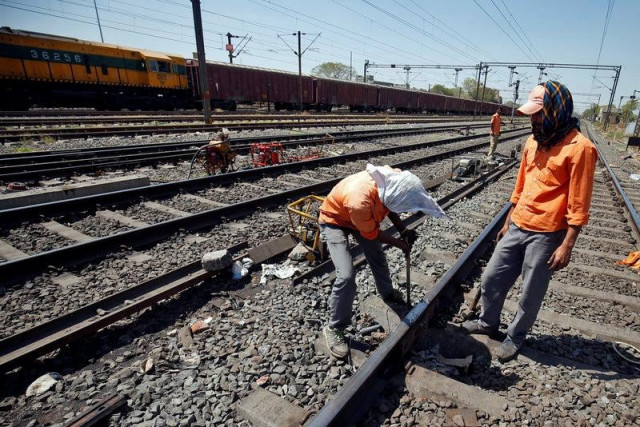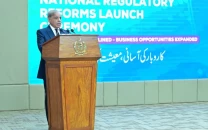CPEC rail project: Govt seeks to avoid financial risks in $9b deal
Puts at least one CPEC energy project of 1,320MW on the back burner

A worker fixes a railway track. PHOTO: REUTERS
In addition, it also put at least one energy project of 1,320 megawatts on the back burner.
The expansion and reconstruction of Karachi-Lahore-Peshawar railway track, known as the Main Line 1 project (ML1), is an early harvest and a strategic project of the CPEC framework.
The change in the modus operandi of constructing the $9 billion project would require amendments to the framework agreement that China and Pakistan had signed in May last year.
The Pakistan Tehreek-e-Insaf (PTI) government has taken the corrective measures amid criticism that the last Pakistan Muslim League-Nawaz (PML-N) government did not fully protect Pakistan’s economic interests while signing the $46 billion deals under the Belt and Road Initiative of the Chinese president.
“The government is exploring the possibility of completing the $9 billion ML1 project of Pakistan Railways on build-operate-transfer (BOT) basis,” said Minister for Planning and Development Khusro Bakhtiar on Thursday.
He was speaking to the media after chairing the 56th monthly progress review meeting of CPEC. The minister also said Pakistan and China have also agreed to set up a new working group on socioeconomic development to deepen cooperation in education, health, agriculture and housing.
Foreign investors seek review of CPEC, free trade deals
He announced conducting a joint study to determine the flow of cargo traffic on the CPEC routes, as the last PML-N government invested $6 billion on two road projects without having scientific projections of the traffic that will flow from China.
“The ML1 project had been conceived to build on the Engineering-Procurement-Construction (EPC) model that shifts the entire financing risks to the federal government,” said Bakhtiar.
“To avoid risks, the government has started exploring the possibility of constructing the project on BOT model,” he added.
In the EPC model, a contractor gets guaranteed price and is responsible from ‘concept to commissioning’ of the project.
Due to its $9 billion cost, there was also a dispute between railways and the Ministry of Finance over the ownership of loan and its servicing.
Sources in the Planning Ministry said the government may have to undertake a new feasibility study before constructing the project on BOT.
However, the minister said it will be in the best interests of Pakistan to complete the ML1 project on the BOT model. Under the original CPEC plan, China had promised to give $2.2 billion out of the then estimated cost of $8.2 billion of the project.
The Asian Development Bank (ADB) was required to give $6 billion loan but China opposed the plan and ousted the ADB. Under the May 2017 framework agreement, the project will solely be funded by China.
According to the Framework Agreement of the ML1, China will provide 85% of the project cost as concessionary loan. The project has been declared ‘strategically important’ by both the countries.
“The PML-N government did not give importance to the ML1 project the way it gave preference to $2 billion Orange Line Project and two road projects worth $6 billion,” said Bakhtiar.
He said the projected cost of the ML1 was $9 billion that has greater economic benefits than the metro and road projects.
The ML1 project has a total length of 1,872 kilometres. The last PML-N government decided to split the project into two due to its high cost and work that requires refurbishment and expansion of the main rail line.
The planning minister also said CPEC will be opened for investment to third countries and two focal persons have been nominated to promote the corridor.
He said Pakistan requires a mammoth $200 billion for infrastructure development that can only be generated with the help of other countries.
He brushed aside criticism on growing indebtedness due to CPEC, saying the share of the CPEC loans was only $6 billion or 6.3% of the total outstanding external debt of $95 billion as of June end.
K-P lawmakers fret fate of CPEC
Energy projects
The federal government also decided to protect all ongoing and planned energy projects under CPEC except the ones that have not achieved financial close and were planned to run on imported fuel, said the planning minister.
The Rahim Yar Khan power plant of 1,320 MW is the only major scheme that has not achieved the financial close. The other project that is planned to be set up on imported coal but has not achieved financial close is 300MW Gwadar power plant. But the project is critical for the supply of power to port city.
“Gwadar that has been ignored in the past will be taken forward as a standalone development project to maximise gains from the potential hub of transshipment,” the planning minister said.
He said the revolving fund of the CPEC energy projects was a main issue.
A Rs22 billion power sector revolving fund was created as a special arrangement to make preferred payments to power producers and investors under CPEC.
The minister; however, assured that Pakistan will honour its all contractual obligations.
He criticised the last PML-N government for its lack of integrated energy planning, which compromised the country’s bargaining position while finalising the deals.
The minister also said tariffs of some of the energy projects were also very high, citing the example of the Quaid-e-Azam solar power plant project that is given 14 cents per unit tariff as against world average of 5 cents.
“In the future, the focus will be on hydro projects. The last government only focused on energy generation projects at the expense of power distribution and transmission schemes,” he added.



















COMMENTS
Comments are moderated and generally will be posted if they are on-topic and not abusive.
For more information, please see our Comments FAQ